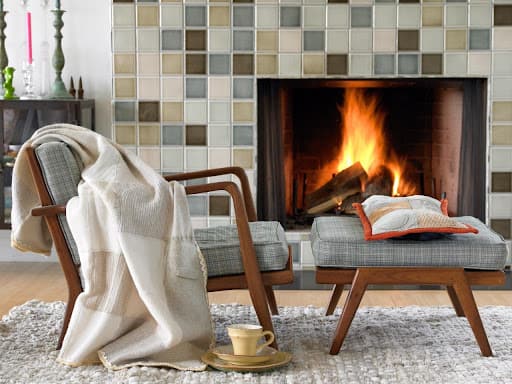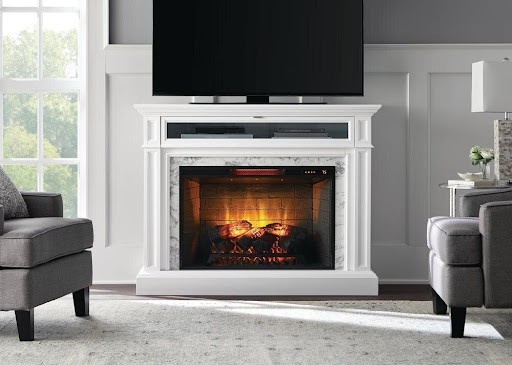Everything You Need to Know: Fireplace Inserts
Posted Thursday, January 14th, 2021
Everything You Need to Know: Fireplace Inserts
 Fireplace Inserts offer many benefits over a conventional fireplace, but only if the insert is properly installed. Let’s talk about fireplace inserts and everything you need to know, starting with your three options.
Fireplace Inserts offer many benefits over a conventional fireplace, but only if the insert is properly installed. Let’s talk about fireplace inserts and everything you need to know, starting with your three options.
There are 3 Types of Fireplace Inserts:
- Wood
- Gas
- Electric
 1. Wood-Burning Fireplace Inserts
1. Wood-Burning Fireplace Inserts
Wood-burning fireplace inserts give much more heat and enjoyment than a conventional masonry fireplace. If you plan on continuing to burn wood fire fires, and you wish for more heat, this is a good choice. Wood fireplace inserts have been around for more than 100 years, and their appeal is obvious.
With a wood insert, you can get more heat without replacing the whole fireplace and chimney. However, with all their features and benefits, there is an installation requirement that not every homeowner is aware of. Wood-burning fireplace inserts need their own exhaust connector and flue.
While the original masonry fireplace and clay flue liner can be used as a passageway, the original chimney flue can not be used to vent the new wood-burning insert.
A connector and chimney system, designed specifically with the wood-burning insert in mind is a necessary addition to a wood-burning stove inserted into a fireplace.
How Much Do Wood Fireplace Inserts Cost?
A DIY wood-burning insert may be found for under $2,000. However, the chimney liner system could cost that much or more. By the time a new liner system, complete installation, and the unit itself is bundled together, the cost could exceed $5,000. But this cost is worth it to ensure the installed fireplace insert is safe and functional.
With a wood insert, you can get more heat without replacing the whole fireplace and chimney. However, with all their features and benefits, there is an installation requirement, not every homeowner is aware of. Wood-burning fireplace inserts need their own exhaust connector and flue.
While the original masonry fireplace and clay flue liner can be used as a passageway, the original chimney flue can not be used to vent the wood-burning insert. A connector and chimney system, designed with the wood-burning insert in mind would be a necessary addition to the wood-burning stove inserted into the fireplace.
How Much Do Wood Fireplace Inserts Cost?
A DIY wood-burning insert may be found for under $2,000. However, the chimney liner system could cost that much or more. By the time the liner system and installation and insert a bundle together cost could exceed $5,000. But this cost is worth it to ensure the installed fireplace insert is safe and functional.
Why is a Chimney Liner Necessary with a Wood Insert?
The original chimney liner used for the fireplace would be too large to vent properly a smaller, wood-burning insert. If the original fireplace liner was used (assuming it’s in good shape) the exhaust would move very slowly and cause excessive creosote build-up.
Creosote build-up through a wood-burning inserts chimney is the number one cause of chimney fires. There are a few ways to minimize chimney fires with wood inserts:
- A properly installed wood insert fireplace and chimney liner system
- Burning good firewood
- Regular chimney sweeping maintenance
- Annual Chimney Inspections
Simply being aware and doing these things regularly will minimize chimney fires when using your fireplace insert.
 2. Gas Fireplace Inserts
2. Gas Fireplace Inserts
If you’re done with wood burning, and you think you’d enjoy the warmth and convenience of gas logs in your fireplace, then consider a gas fireplace insert.
Direct Vent Gas Inserts are a popular choice for fireplaces with a gas supply installed or available. Burning a gas insert fireplace that is direct vented, performs well without using inside air for combustion. In other words, both the air for combustion and the exhaust vent outside.
Can a Gas Insert Use the Existing Fireplaces Chimney?
Direct Vent appliances utilize outside air and exhaust fumes to the outdoors. It is for this reason Direct Vent Fireplace Inserts has two vents. One vent draws in air and the other exhausts it outside. All Direct Vent units have this feature.
Do Gas Fireplace Inserts Have Blowers?
Direct Vent gas inserts have the assorted features most hearth lovers are looking for. Blowers to help move the heat into the room, remote controls, accent lighting are a few of the available features found on many fireplace inserts that burn gas.
In addition to the gas insert itself, additional considerations are the direct venting necessary for the appliance, as well as a tested and proper gas supply. Electricity is also a common requirement for many types of inserts, especially electric fireplace inserts.
Do Fireplace Inserts Need Electricity?
Simple wood-burning fireplace inserts and some gas log inserts may not require household electricity (110vac). However, if a blower (fan) is wanted then the fireplace insert would require a cord to be run to a nearby outlet in the room. Or (if manufacture/local code allows) an axillary outlet installed in the firebox. As expected ALL electrical fireplace inserts would need an adequate source of electrical supply.
3. Electric Fireplace Inserts
Electric Fireplace Inserts are fairly new on the fireplace hearth seen, using color lights (LEDs) and other electronic features, they reproduce a life-like appearance that mimics a real fire surrounded by artificial logs. Because electric fireplace inserts do not have a real open flame, they produce very little heat from actual combustion. Many electric fireplace inserts have features of a heating element, that is, they produce heat from elements that glow hot with the use of only electricity.
Do Electric Inserts Need a Chimney?
Unlike wood-burning and direct vent systems, electric fireplaces do not need a chimney to vent combustible byproducts. However, they do have other unique needs that wood and gas-burning inserts may not require.
Electric fireplace inserts use resistance from electrical elements to generate warm air for the room. Electrical heating appliances consume additional electricity beyond lights and a blower.
Only verified electrical circuits should be used with all heating appliances, especially electrical fireplace inserts.
 Yes, Electrical fireplace inserts are spectacular. Since the heat-producing element is a separate circuit, they often can be enjoyed with the electrical element off.
Yes, Electrical fireplace inserts are spectacular. Since the heat-producing element is a separate circuit, they often can be enjoyed with the electrical element off.
Cressy Door and Fireplace is your trusted resource for all information related to Seattle area fireplace sales, installation, and service of your fireplace. (Picture Above Is Not Our Showroom) Whether you are replacing an old wood-burning fireplace or installing multiple fireplaces at a new construction residential property, the team of local Puget Sound and Seattle fireplace sales and installation experts at Cressy Door and Fireplace are at your service. We have a wide selection of Seattle’s best wood-burning, electric, and gas fireplaces including gas inserts, wood inserts, electric fireplaces, and outdoor fireplaces.
Choose from the best brands in the industry including Astria, Regency, IronStrike, Monesson, Town & Country, Montigo, RH Peterson, Heat-N-Glo, and Amanti.